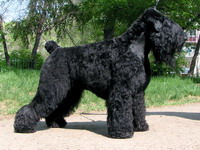Team Voice
 With a young dog, you can work out the command “Voice!”. This skill is very useful when working out methods of security training (for example, when a stranger is detected in a room or shelter or as a warning signal). Practicing exercises produce as long as the dog will not give voice in a variety of situations.
With a young dog, you can work out the command “Voice!”. This skill is very useful when working out methods of security training (for example, when a stranger is detected in a room or shelter or as a warning signal). Practicing exercises produce as long as the dog will not give voice in a variety of situations.
Representatives of more temperamental breeds who are accustomed to accompanying their actions with barking (for example, German, Scottish and Belgian shepherds, Dobermans, Airedale terriers, etc.), undoubtedly, are easier to train this team than “silent” (such as rottweilers and mastiffs).
The first way. Seat the dog in front of you, fasten the leash, and take the end with the loop in your left hand. In the right hand clamped delicacy. With your left foot, step on a loose sag, and hold your right hand right in front of the dog’s nose so that it smells the treat. Energetically say: “Voice!”. As if teasing your pet, raise your right hand up. The dog will try to jump after the meal, but the leash will keep it in a sitting position. Repeat the “teaser” several times, saying “Voice! Vote!”. In the end, the annoyed dog will start barking. Immediately give a treat and praise for ingenuity.
Team Voice
The second way. It can be recommended if the puppy is already attached enough to its owner. In a certain place of the daily walking route, the owner ties the dog with a long leash to a tree or pole and silently leaves. At a distance of about 10 meters, he stops, turns to the pet and waits, standing motionless, for a while. The dog is watching him intensely. Further, the person slowly raises his hand and invokingly says “Voice!”. As soon as the dog makes even the slightest sound, be it a scream or a short barking, the owner hurries to his pet and treats him with a treat. The exercise is repeated 2–3 times. If the dog does not perform the required actions, then the explosive distance increases, the owner may be completely removed from the field of view of the dog, hiding behind a bush or a corner of the building. At the slightest hint of a voice call, he leaves the shelter and rewards the dog.
If this method has not justified itself, try to provoke barking by ringing or knocking on the front door. Usually this method works for self-confident animals with developed protective instinct. As soon as there is a loud knock, the dog will respond to the signal and rush to the door with a bark, and you let the “Voice!” Command follow. Then proceed to the door and there praise the dog, and after half an hour, repeat the exercise.
The voice exercise has another advantage. With it, you can teach silence too many barking dogs. The condition for this skill is that any exercise in voice casting ends with a non-standard “Silence!” Command. The same beep is used if the dog starts barking at the wrong time. Here you can also come in handy tidbit. If the dog is too zealously performing the duties of a watchdog, gently pat it on the nose, at the same time saying: “Quiet! Quiet!”.



